University Project: BUS353e Project Management HPSS Project Analysis
VerifiedAdded on 2020/02/18
|14
|3573
|26
Project
AI Summary
This project report analyzes the HPSS project, focusing on various aspects of project management. Section 1 defines the project, emphasizing candidate screening, team formation, and the establishment of common goals and a priority matrix. Section 2 addresses resource scheduling and cost, utilizing Gantt charts and resource leveling techniques to optimize the project timeline. Section 3 explores methods for reducing project duration and cost, including scope management and schedule adjustments. Finally, Section 4 covers project progress monitoring and closing procedures, incorporating tracking Gantt charts and cost variance analysis to ensure project success. The report provides a comprehensive overview of project management principles applied to a real-world scenario, demonstrating the importance of effective planning, resource allocation, and cost control in achieving project objectives.
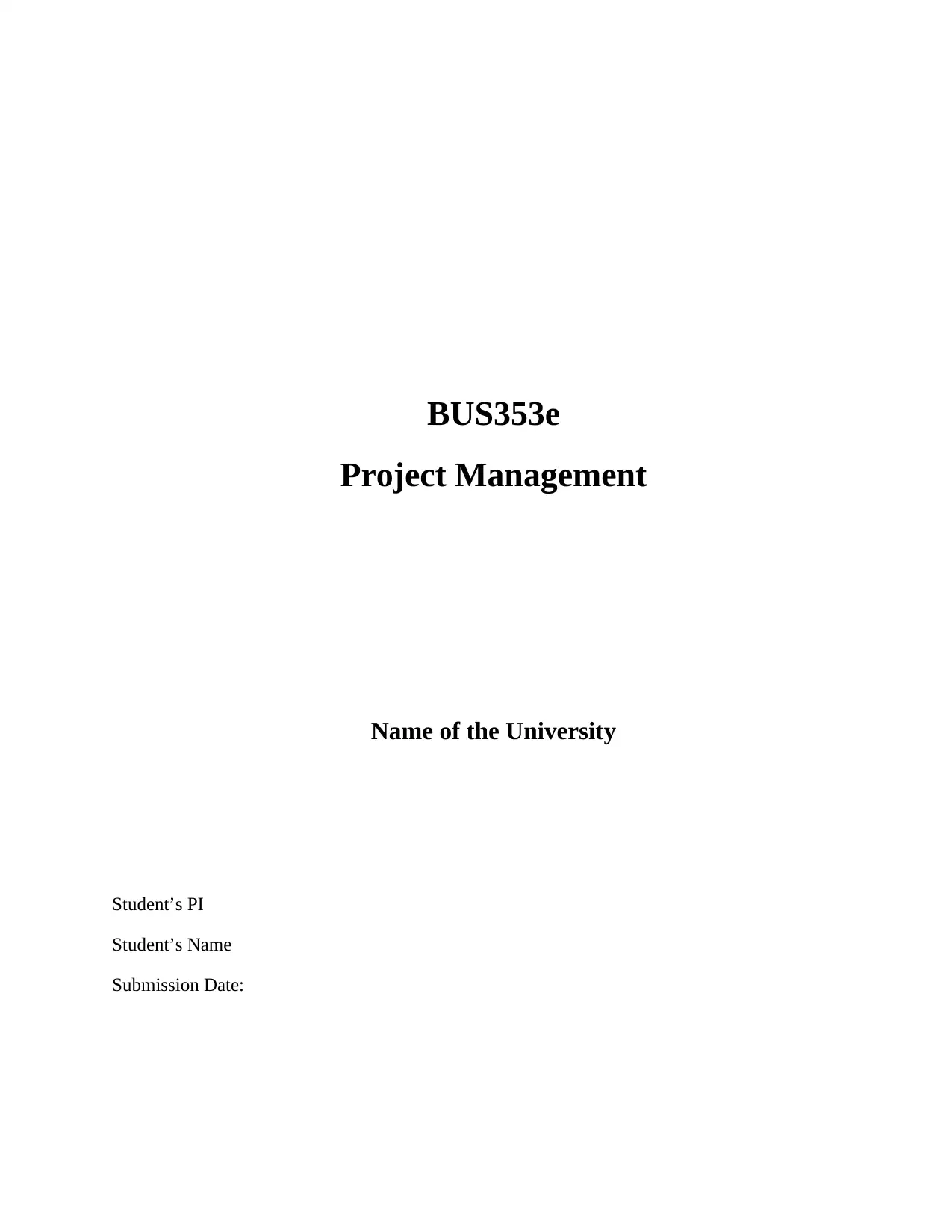
BUS353e
Project Management
Name of the University
Student’s PI
Student’s Name
Submission Date:
Project Management
Name of the University
Student’s PI
Student’s Name
Submission Date:
Paraphrase This Document
Need a fresh take? Get an instant paraphrase of this document with our AI Paraphraser
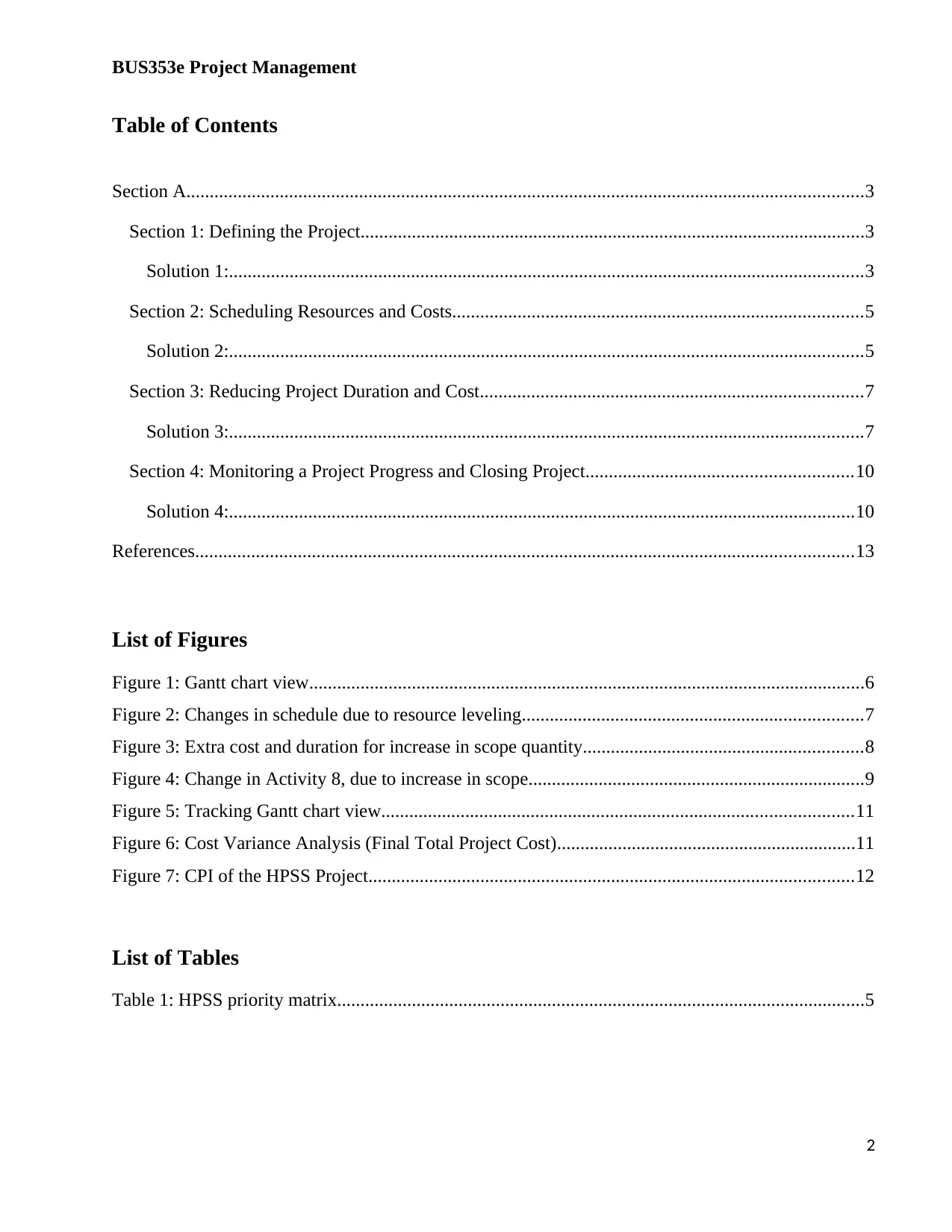
BUS353e Project Management
Table of Contents
Section A.................................................................................................................................................3
Section 1: Defining the Project............................................................................................................3
Solution 1:........................................................................................................................................3
Section 2: Scheduling Resources and Costs........................................................................................5
Solution 2:........................................................................................................................................5
Section 3: Reducing Project Duration and Cost..................................................................................7
Solution 3:........................................................................................................................................7
Section 4: Monitoring a Project Progress and Closing Project.........................................................10
Solution 4:......................................................................................................................................10
References.............................................................................................................................................13
List of Figures
Figure 1: Gantt chart view.......................................................................................................................6
Figure 2: Changes in schedule due to resource leveling.........................................................................7
Figure 3: Extra cost and duration for increase in scope quantity............................................................8
Figure 4: Change in Activity 8, due to increase in scope........................................................................9
Figure 5: Tracking Gantt chart view.....................................................................................................11
Figure 6: Cost Variance Analysis (Final Total Project Cost)................................................................11
Figure 7: CPI of the HPSS Project........................................................................................................12
List of Tables
Table 1: HPSS priority matrix.................................................................................................................5
2
Table of Contents
Section A.................................................................................................................................................3
Section 1: Defining the Project............................................................................................................3
Solution 1:........................................................................................................................................3
Section 2: Scheduling Resources and Costs........................................................................................5
Solution 2:........................................................................................................................................5
Section 3: Reducing Project Duration and Cost..................................................................................7
Solution 3:........................................................................................................................................7
Section 4: Monitoring a Project Progress and Closing Project.........................................................10
Solution 4:......................................................................................................................................10
References.............................................................................................................................................13
List of Figures
Figure 1: Gantt chart view.......................................................................................................................6
Figure 2: Changes in schedule due to resource leveling.........................................................................7
Figure 3: Extra cost and duration for increase in scope quantity............................................................8
Figure 4: Change in Activity 8, due to increase in scope........................................................................9
Figure 5: Tracking Gantt chart view.....................................................................................................11
Figure 6: Cost Variance Analysis (Final Total Project Cost)................................................................11
Figure 7: CPI of the HPSS Project........................................................................................................12
List of Tables
Table 1: HPSS priority matrix.................................................................................................................5
2
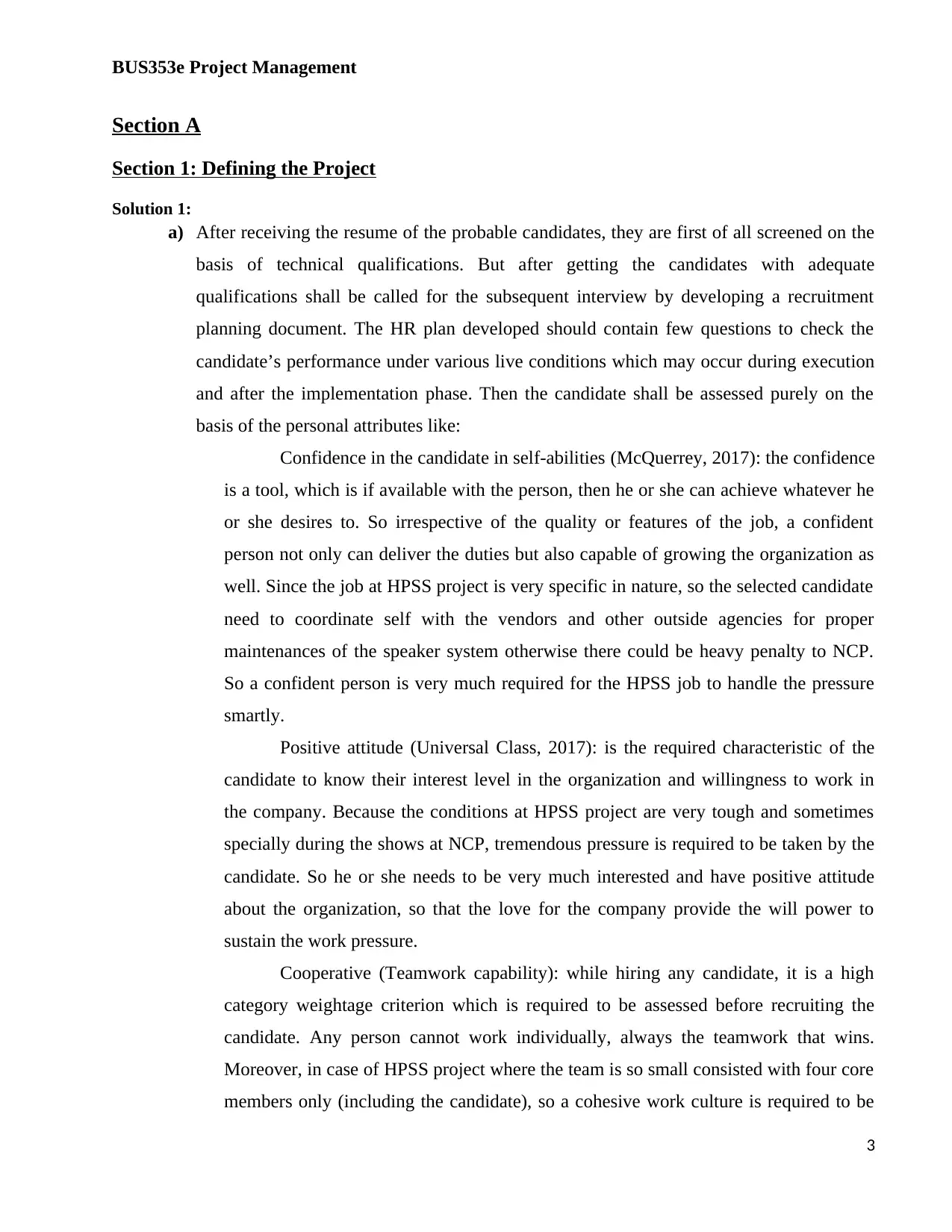
BUS353e Project Management
Section A
Section 1: Defining the Project
Solution 1:
a) After receiving the resume of the probable candidates, they are first of all screened on the
basis of technical qualifications. But after getting the candidates with adequate
qualifications shall be called for the subsequent interview by developing a recruitment
planning document. The HR plan developed should contain few questions to check the
candidate’s performance under various live conditions which may occur during execution
and after the implementation phase. Then the candidate shall be assessed purely on the
basis of the personal attributes like:
Confidence in the candidate in self-abilities (McQuerrey, 2017): the confidence
is a tool, which is if available with the person, then he or she can achieve whatever he
or she desires to. So irrespective of the quality or features of the job, a confident
person not only can deliver the duties but also capable of growing the organization as
well. Since the job at HPSS project is very specific in nature, so the selected candidate
need to coordinate self with the vendors and other outside agencies for proper
maintenances of the speaker system otherwise there could be heavy penalty to NCP.
So a confident person is very much required for the HPSS job to handle the pressure
smartly.
Positive attitude (Universal Class, 2017): is the required characteristic of the
candidate to know their interest level in the organization and willingness to work in
the company. Because the conditions at HPSS project are very tough and sometimes
specially during the shows at NCP, tremendous pressure is required to be taken by the
candidate. So he or she needs to be very much interested and have positive attitude
about the organization, so that the love for the company provide the will power to
sustain the work pressure.
Cooperative (Teamwork capability): while hiring any candidate, it is a high
category weightage criterion which is required to be assessed before recruiting the
candidate. Any person cannot work individually, always the teamwork that wins.
Moreover, in case of HPSS project where the team is so small consisted with four core
members only (including the candidate), so a cohesive work culture is required to be
3
Section A
Section 1: Defining the Project
Solution 1:
a) After receiving the resume of the probable candidates, they are first of all screened on the
basis of technical qualifications. But after getting the candidates with adequate
qualifications shall be called for the subsequent interview by developing a recruitment
planning document. The HR plan developed should contain few questions to check the
candidate’s performance under various live conditions which may occur during execution
and after the implementation phase. Then the candidate shall be assessed purely on the
basis of the personal attributes like:
Confidence in the candidate in self-abilities (McQuerrey, 2017): the confidence
is a tool, which is if available with the person, then he or she can achieve whatever he
or she desires to. So irrespective of the quality or features of the job, a confident
person not only can deliver the duties but also capable of growing the organization as
well. Since the job at HPSS project is very specific in nature, so the selected candidate
need to coordinate self with the vendors and other outside agencies for proper
maintenances of the speaker system otherwise there could be heavy penalty to NCP.
So a confident person is very much required for the HPSS job to handle the pressure
smartly.
Positive attitude (Universal Class, 2017): is the required characteristic of the
candidate to know their interest level in the organization and willingness to work in
the company. Because the conditions at HPSS project are very tough and sometimes
specially during the shows at NCP, tremendous pressure is required to be taken by the
candidate. So he or she needs to be very much interested and have positive attitude
about the organization, so that the love for the company provide the will power to
sustain the work pressure.
Cooperative (Teamwork capability): while hiring any candidate, it is a high
category weightage criterion which is required to be assessed before recruiting the
candidate. Any person cannot work individually, always the teamwork that wins.
Moreover, in case of HPSS project where the team is so small consisted with four core
members only (including the candidate), so a cohesive work culture is required to be
3
⊘ This is a preview!⊘
Do you want full access?
Subscribe today to unlock all pages.

Trusted by 1+ million students worldwide
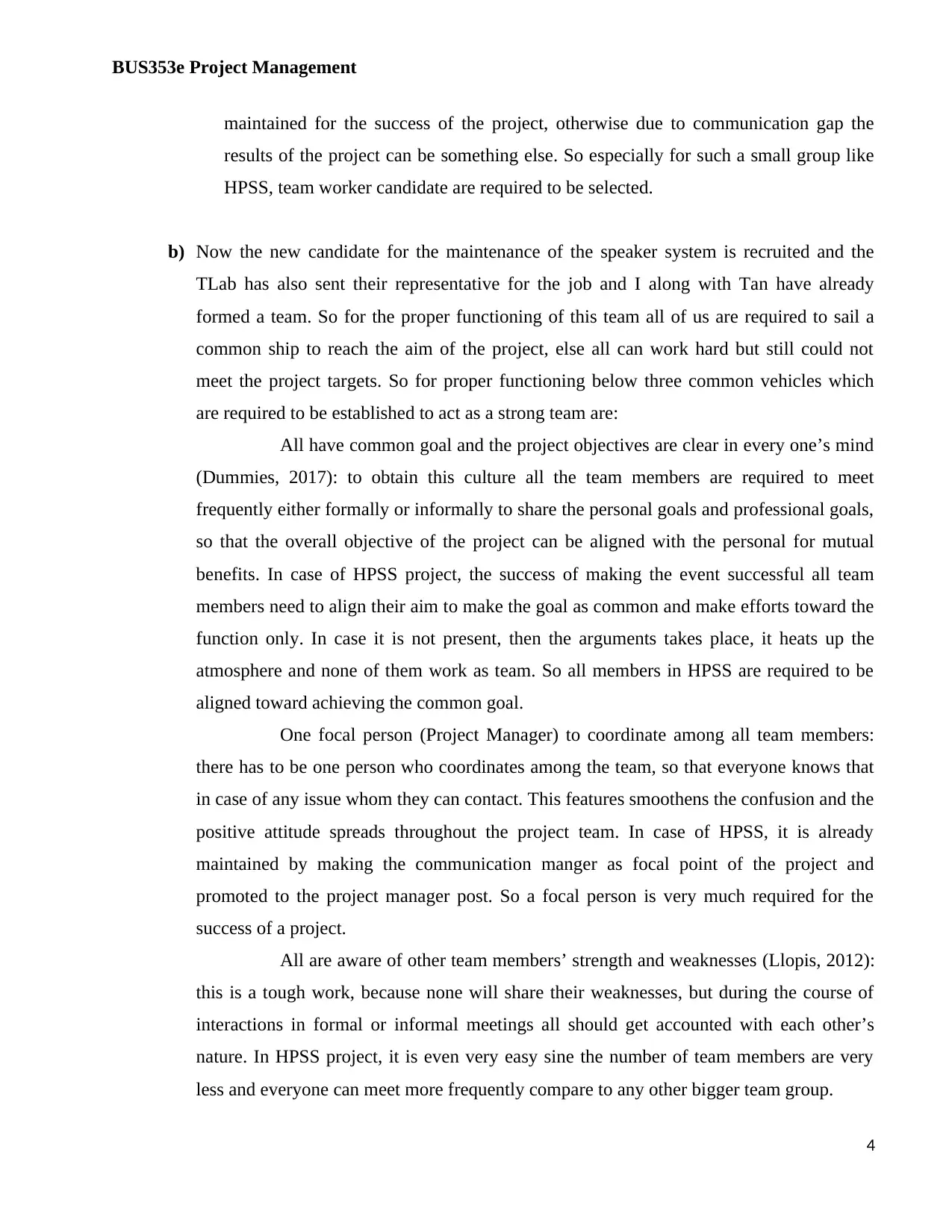
BUS353e Project Management
maintained for the success of the project, otherwise due to communication gap the
results of the project can be something else. So especially for such a small group like
HPSS, team worker candidate are required to be selected.
b) Now the new candidate for the maintenance of the speaker system is recruited and the
TLab has also sent their representative for the job and I along with Tan have already
formed a team. So for the proper functioning of this team all of us are required to sail a
common ship to reach the aim of the project, else all can work hard but still could not
meet the project targets. So for proper functioning below three common vehicles which
are required to be established to act as a strong team are:
All have common goal and the project objectives are clear in every one’s mind
(Dummies, 2017): to obtain this culture all the team members are required to meet
frequently either formally or informally to share the personal goals and professional goals,
so that the overall objective of the project can be aligned with the personal for mutual
benefits. In case of HPSS project, the success of making the event successful all team
members need to align their aim to make the goal as common and make efforts toward the
function only. In case it is not present, then the arguments takes place, it heats up the
atmosphere and none of them work as team. So all members in HPSS are required to be
aligned toward achieving the common goal.
One focal person (Project Manager) to coordinate among all team members:
there has to be one person who coordinates among the team, so that everyone knows that
in case of any issue whom they can contact. This features smoothens the confusion and the
positive attitude spreads throughout the project team. In case of HPSS, it is already
maintained by making the communication manger as focal point of the project and
promoted to the project manager post. So a focal person is very much required for the
success of a project.
All are aware of other team members’ strength and weaknesses (Llopis, 2012):
this is a tough work, because none will share their weaknesses, but during the course of
interactions in formal or informal meetings all should get accounted with each other’s
nature. In HPSS project, it is even very easy sine the number of team members are very
less and everyone can meet more frequently compare to any other bigger team group.
4
maintained for the success of the project, otherwise due to communication gap the
results of the project can be something else. So especially for such a small group like
HPSS, team worker candidate are required to be selected.
b) Now the new candidate for the maintenance of the speaker system is recruited and the
TLab has also sent their representative for the job and I along with Tan have already
formed a team. So for the proper functioning of this team all of us are required to sail a
common ship to reach the aim of the project, else all can work hard but still could not
meet the project targets. So for proper functioning below three common vehicles which
are required to be established to act as a strong team are:
All have common goal and the project objectives are clear in every one’s mind
(Dummies, 2017): to obtain this culture all the team members are required to meet
frequently either formally or informally to share the personal goals and professional goals,
so that the overall objective of the project can be aligned with the personal for mutual
benefits. In case of HPSS project, the success of making the event successful all team
members need to align their aim to make the goal as common and make efforts toward the
function only. In case it is not present, then the arguments takes place, it heats up the
atmosphere and none of them work as team. So all members in HPSS are required to be
aligned toward achieving the common goal.
One focal person (Project Manager) to coordinate among all team members:
there has to be one person who coordinates among the team, so that everyone knows that
in case of any issue whom they can contact. This features smoothens the confusion and the
positive attitude spreads throughout the project team. In case of HPSS, it is already
maintained by making the communication manger as focal point of the project and
promoted to the project manager post. So a focal person is very much required for the
success of a project.
All are aware of other team members’ strength and weaknesses (Llopis, 2012):
this is a tough work, because none will share their weaknesses, but during the course of
interactions in formal or informal meetings all should get accounted with each other’s
nature. In HPSS project, it is even very easy sine the number of team members are very
less and everyone can meet more frequently compare to any other bigger team group.
4
Paraphrase This Document
Need a fresh take? Get an instant paraphrase of this document with our AI Paraphraser
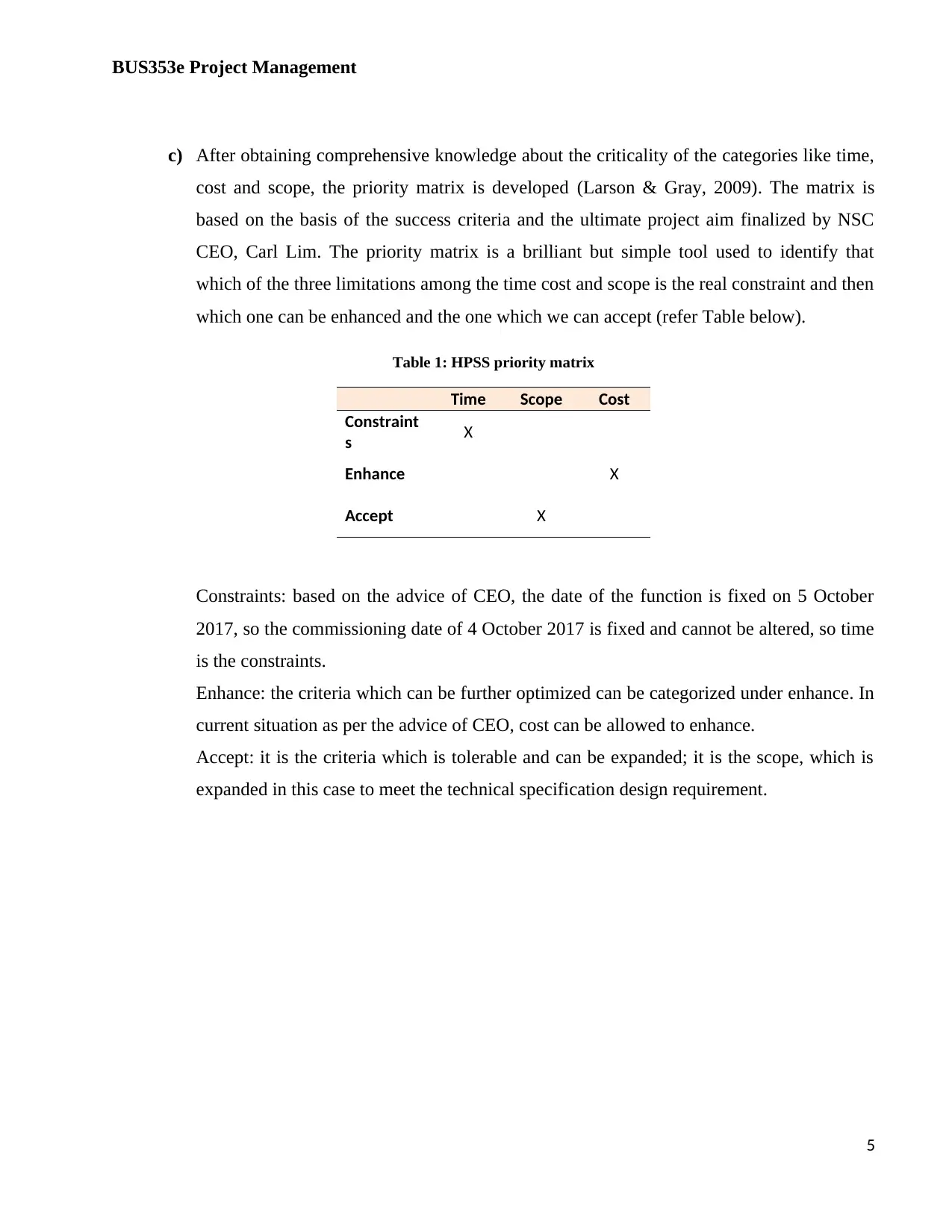
BUS353e Project Management
c) After obtaining comprehensive knowledge about the criticality of the categories like time,
cost and scope, the priority matrix is developed (Larson & Gray, 2009). The matrix is
based on the basis of the success criteria and the ultimate project aim finalized by NSC
CEO, Carl Lim. The priority matrix is a brilliant but simple tool used to identify that
which of the three limitations among the time cost and scope is the real constraint and then
which one can be enhanced and the one which we can accept (refer Table below).
Table 1: HPSS priority matrix
Time Scope Cost
Constraint
s X
Enhance X
Accept X
Constraints: based on the advice of CEO, the date of the function is fixed on 5 October
2017, so the commissioning date of 4 October 2017 is fixed and cannot be altered, so time
is the constraints.
Enhance: the criteria which can be further optimized can be categorized under enhance. In
current situation as per the advice of CEO, cost can be allowed to enhance.
Accept: it is the criteria which is tolerable and can be expanded; it is the scope, which is
expanded in this case to meet the technical specification design requirement.
5
c) After obtaining comprehensive knowledge about the criticality of the categories like time,
cost and scope, the priority matrix is developed (Larson & Gray, 2009). The matrix is
based on the basis of the success criteria and the ultimate project aim finalized by NSC
CEO, Carl Lim. The priority matrix is a brilliant but simple tool used to identify that
which of the three limitations among the time cost and scope is the real constraint and then
which one can be enhanced and the one which we can accept (refer Table below).
Table 1: HPSS priority matrix
Time Scope Cost
Constraint
s X
Enhance X
Accept X
Constraints: based on the advice of CEO, the date of the function is fixed on 5 October
2017, so the commissioning date of 4 October 2017 is fixed and cannot be altered, so time
is the constraints.
Enhance: the criteria which can be further optimized can be categorized under enhance. In
current situation as per the advice of CEO, cost can be allowed to enhance.
Accept: it is the criteria which is tolerable and can be expanded; it is the scope, which is
expanded in this case to meet the technical specification design requirement.
5
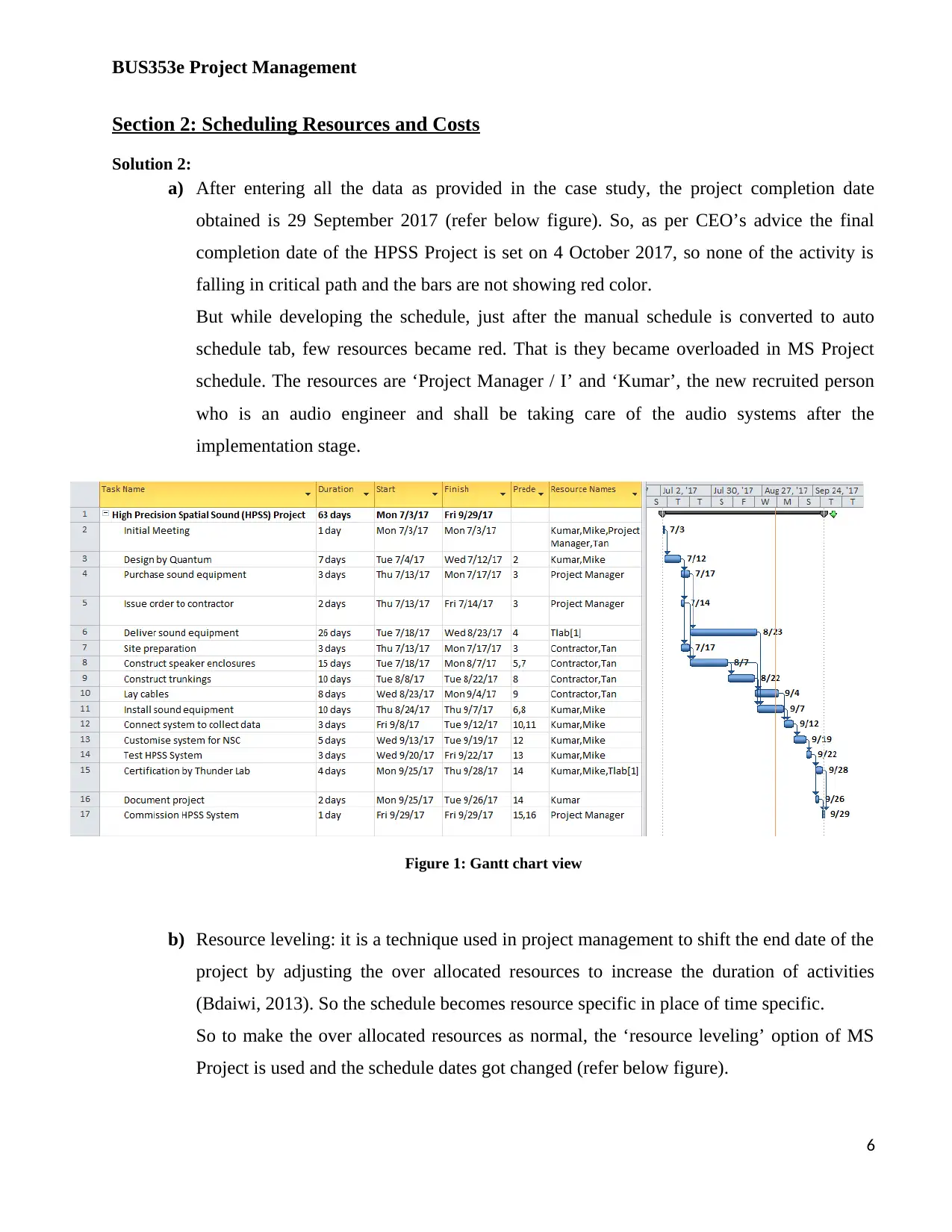
BUS353e Project Management
Section 2: Scheduling Resources and Costs
Solution 2:
a) After entering all the data as provided in the case study, the project completion date
obtained is 29 September 2017 (refer below figure). So, as per CEO’s advice the final
completion date of the HPSS Project is set on 4 October 2017, so none of the activity is
falling in critical path and the bars are not showing red color.
But while developing the schedule, just after the manual schedule is converted to auto
schedule tab, few resources became red. That is they became overloaded in MS Project
schedule. The resources are ‘Project Manager / I’ and ‘Kumar’, the new recruited person
who is an audio engineer and shall be taking care of the audio systems after the
implementation stage.
Figure 1: Gantt chart view
b) Resource leveling: it is a technique used in project management to shift the end date of the
project by adjusting the over allocated resources to increase the duration of activities
(Bdaiwi, 2013). So the schedule becomes resource specific in place of time specific.
So to make the over allocated resources as normal, the ‘resource leveling’ option of MS
Project is used and the schedule dates got changed (refer below figure).
6
Section 2: Scheduling Resources and Costs
Solution 2:
a) After entering all the data as provided in the case study, the project completion date
obtained is 29 September 2017 (refer below figure). So, as per CEO’s advice the final
completion date of the HPSS Project is set on 4 October 2017, so none of the activity is
falling in critical path and the bars are not showing red color.
But while developing the schedule, just after the manual schedule is converted to auto
schedule tab, few resources became red. That is they became overloaded in MS Project
schedule. The resources are ‘Project Manager / I’ and ‘Kumar’, the new recruited person
who is an audio engineer and shall be taking care of the audio systems after the
implementation stage.
Figure 1: Gantt chart view
b) Resource leveling: it is a technique used in project management to shift the end date of the
project by adjusting the over allocated resources to increase the duration of activities
(Bdaiwi, 2013). So the schedule becomes resource specific in place of time specific.
So to make the over allocated resources as normal, the ‘resource leveling’ option of MS
Project is used and the schedule dates got changed (refer below figure).
6
⊘ This is a preview!⊘
Do you want full access?
Subscribe today to unlock all pages.

Trusted by 1+ million students worldwide
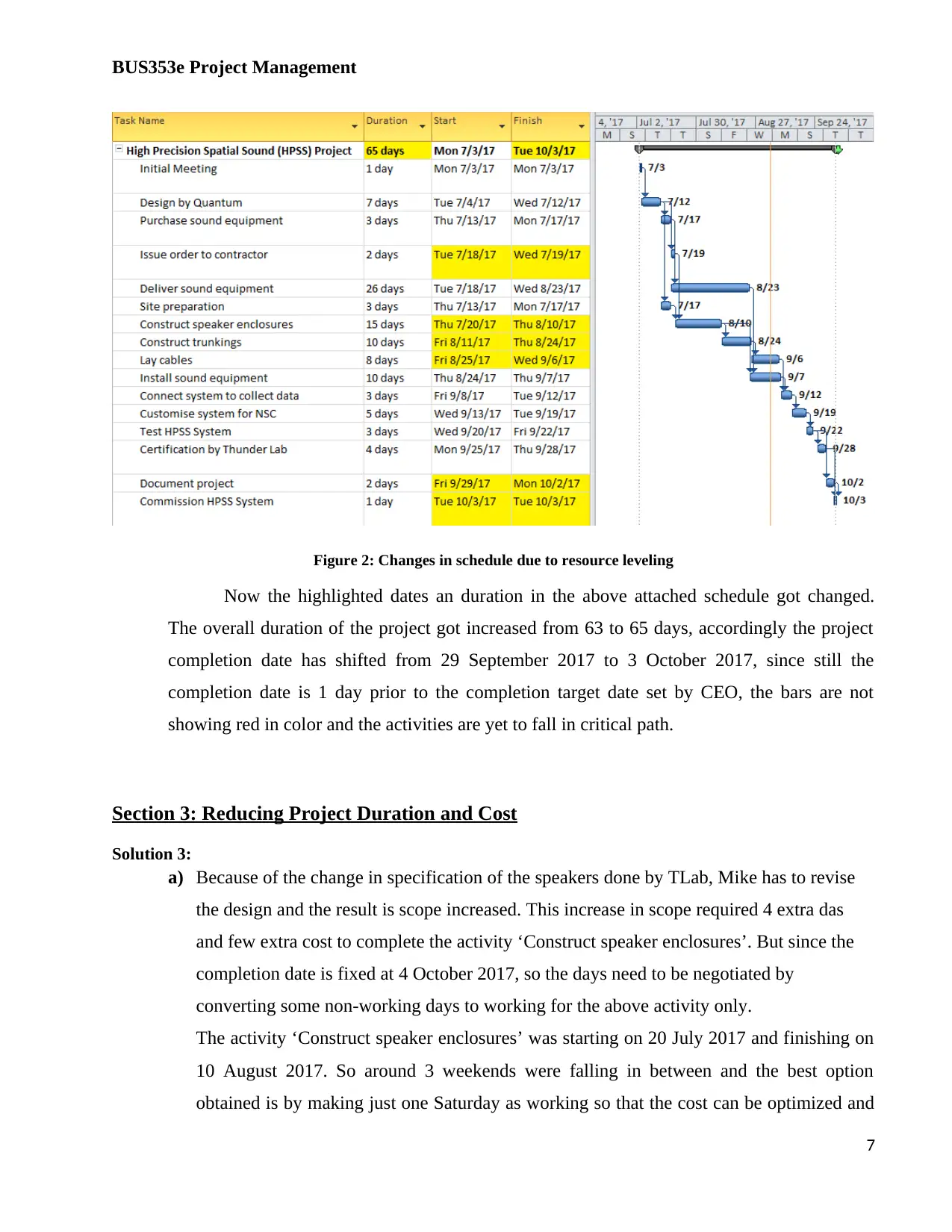
BUS353e Project Management
Figure 2: Changes in schedule due to resource leveling
Now the highlighted dates an duration in the above attached schedule got changed.
The overall duration of the project got increased from 63 to 65 days, accordingly the project
completion date has shifted from 29 September 2017 to 3 October 2017, since still the
completion date is 1 day prior to the completion target date set by CEO, the bars are not
showing red in color and the activities are yet to fall in critical path.
Section 3: Reducing Project Duration and Cost
Solution 3:
a) Because of the change in specification of the speakers done by TLab, Mike has to revise
the design and the result is scope increased. This increase in scope required 4 extra das
and few extra cost to complete the activity ‘Construct speaker enclosures’. But since the
completion date is fixed at 4 October 2017, so the days need to be negotiated by
converting some non-working days to working for the above activity only.
The activity ‘Construct speaker enclosures’ was starting on 20 July 2017 and finishing on
10 August 2017. So around 3 weekends were falling in between and the best option
obtained is by making just one Saturday as working so that the cost can be optimized and
7
Figure 2: Changes in schedule due to resource leveling
Now the highlighted dates an duration in the above attached schedule got changed.
The overall duration of the project got increased from 63 to 65 days, accordingly the project
completion date has shifted from 29 September 2017 to 3 October 2017, since still the
completion date is 1 day prior to the completion target date set by CEO, the bars are not
showing red in color and the activities are yet to fall in critical path.
Section 3: Reducing Project Duration and Cost
Solution 3:
a) Because of the change in specification of the speakers done by TLab, Mike has to revise
the design and the result is scope increased. This increase in scope required 4 extra das
and few extra cost to complete the activity ‘Construct speaker enclosures’. But since the
completion date is fixed at 4 October 2017, so the days need to be negotiated by
converting some non-working days to working for the above activity only.
The activity ‘Construct speaker enclosures’ was starting on 20 July 2017 and finishing on
10 August 2017. So around 3 weekends were falling in between and the best option
obtained is by making just one Saturday as working so that the cost can be optimized and
7
Paraphrase This Document
Need a fresh take? Get an instant paraphrase of this document with our AI Paraphraser
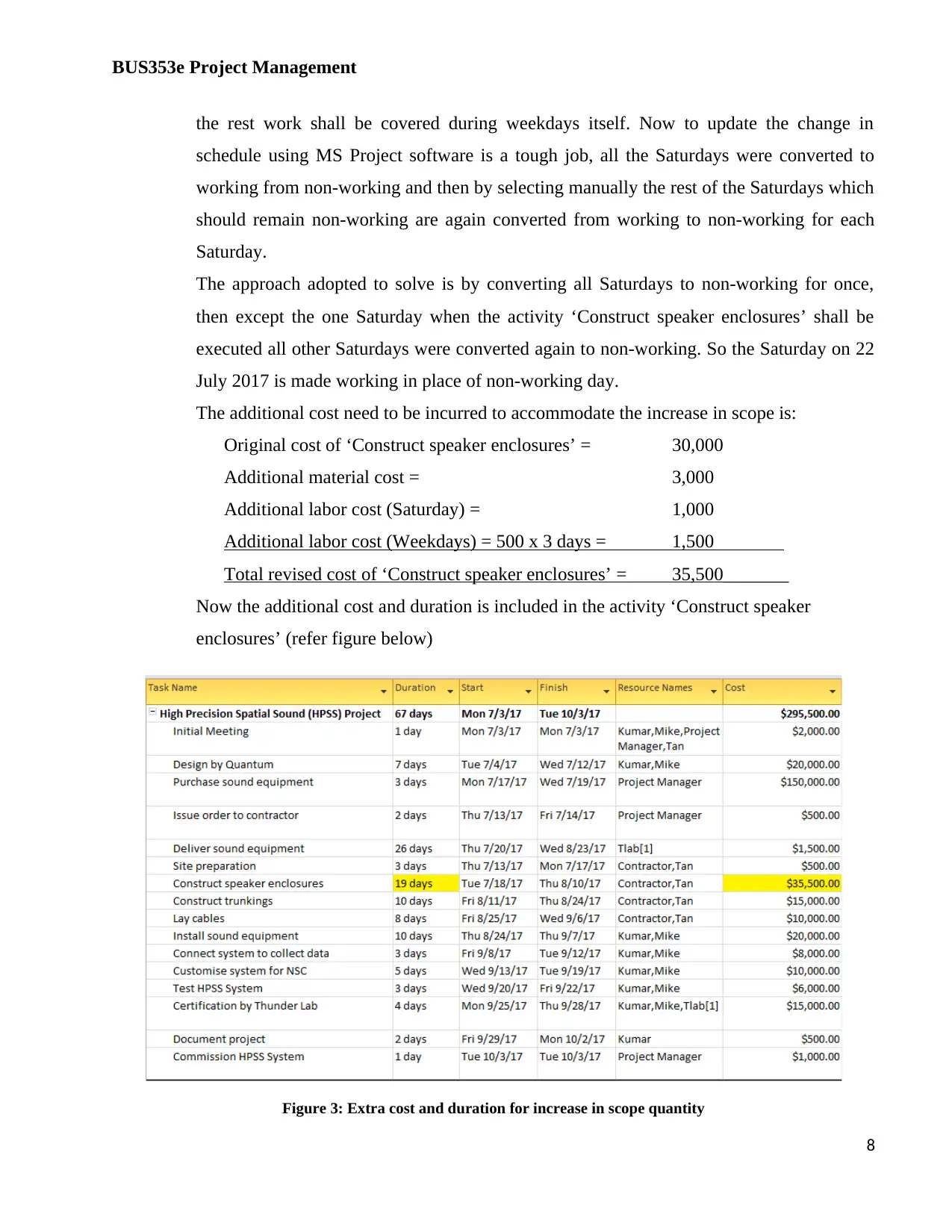
BUS353e Project Management
the rest work shall be covered during weekdays itself. Now to update the change in
schedule using MS Project software is a tough job, all the Saturdays were converted to
working from non-working and then by selecting manually the rest of the Saturdays which
should remain non-working are again converted from working to non-working for each
Saturday.
The approach adopted to solve is by converting all Saturdays to non-working for once,
then except the one Saturday when the activity ‘Construct speaker enclosures’ shall be
executed all other Saturdays were converted again to non-working. So the Saturday on 22
July 2017 is made working in place of non-working day.
The additional cost need to be incurred to accommodate the increase in scope is:
Original cost of ‘Construct speaker enclosures’ = 30,000
Additional material cost = 3,000
Additional labor cost (Saturday) = 1,000
Additional labor cost (Weekdays) = 500 x 3 days = 1,500
Total revised cost of ‘Construct speaker enclosures’ = 35,500_______
Now the additional cost and duration is included in the activity ‘Construct speaker
enclosures’ (refer figure below)
Figure 3: Extra cost and duration for increase in scope quantity
8
the rest work shall be covered during weekdays itself. Now to update the change in
schedule using MS Project software is a tough job, all the Saturdays were converted to
working from non-working and then by selecting manually the rest of the Saturdays which
should remain non-working are again converted from working to non-working for each
Saturday.
The approach adopted to solve is by converting all Saturdays to non-working for once,
then except the one Saturday when the activity ‘Construct speaker enclosures’ shall be
executed all other Saturdays were converted again to non-working. So the Saturday on 22
July 2017 is made working in place of non-working day.
The additional cost need to be incurred to accommodate the increase in scope is:
Original cost of ‘Construct speaker enclosures’ = 30,000
Additional material cost = 3,000
Additional labor cost (Saturday) = 1,000
Additional labor cost (Weekdays) = 500 x 3 days = 1,500
Total revised cost of ‘Construct speaker enclosures’ = 35,500_______
Now the additional cost and duration is included in the activity ‘Construct speaker
enclosures’ (refer figure below)
Figure 3: Extra cost and duration for increase in scope quantity
8
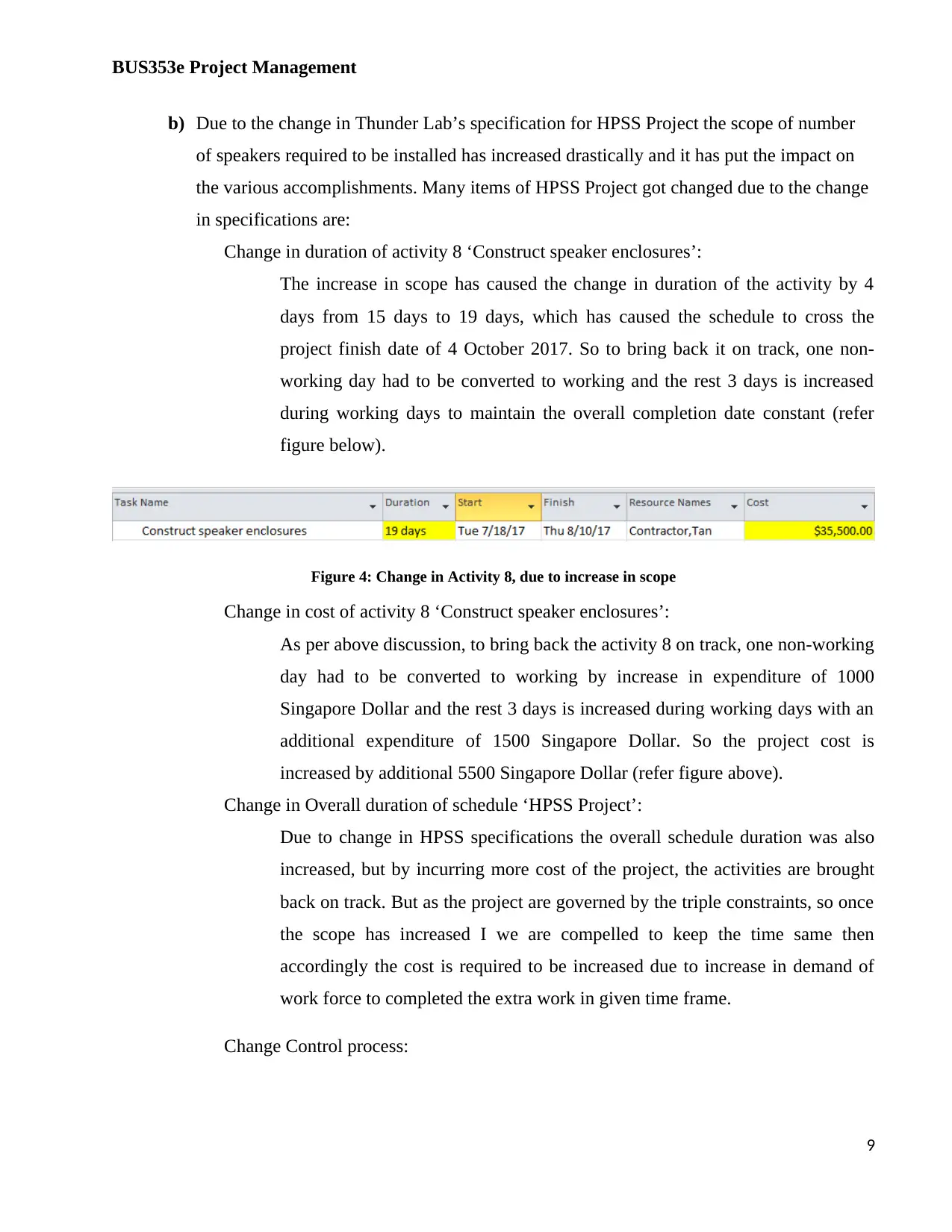
BUS353e Project Management
b) Due to the change in Thunder Lab’s specification for HPSS Project the scope of number
of speakers required to be installed has increased drastically and it has put the impact on
the various accomplishments. Many items of HPSS Project got changed due to the change
in specifications are:
Change in duration of activity 8 ‘Construct speaker enclosures’:
The increase in scope has caused the change in duration of the activity by 4
days from 15 days to 19 days, which has caused the schedule to cross the
project finish date of 4 October 2017. So to bring back it on track, one non-
working day had to be converted to working and the rest 3 days is increased
during working days to maintain the overall completion date constant (refer
figure below).
Figure 4: Change in Activity 8, due to increase in scope
Change in cost of activity 8 ‘Construct speaker enclosures’:
As per above discussion, to bring back the activity 8 on track, one non-working
day had to be converted to working by increase in expenditure of 1000
Singapore Dollar and the rest 3 days is increased during working days with an
additional expenditure of 1500 Singapore Dollar. So the project cost is
increased by additional 5500 Singapore Dollar (refer figure above).
Change in Overall duration of schedule ‘HPSS Project’:
Due to change in HPSS specifications the overall schedule duration was also
increased, but by incurring more cost of the project, the activities are brought
back on track. But as the project are governed by the triple constraints, so once
the scope has increased I we are compelled to keep the time same then
accordingly the cost is required to be increased due to increase in demand of
work force to completed the extra work in given time frame.
Change Control process:
9
b) Due to the change in Thunder Lab’s specification for HPSS Project the scope of number
of speakers required to be installed has increased drastically and it has put the impact on
the various accomplishments. Many items of HPSS Project got changed due to the change
in specifications are:
Change in duration of activity 8 ‘Construct speaker enclosures’:
The increase in scope has caused the change in duration of the activity by 4
days from 15 days to 19 days, which has caused the schedule to cross the
project finish date of 4 October 2017. So to bring back it on track, one non-
working day had to be converted to working and the rest 3 days is increased
during working days to maintain the overall completion date constant (refer
figure below).
Figure 4: Change in Activity 8, due to increase in scope
Change in cost of activity 8 ‘Construct speaker enclosures’:
As per above discussion, to bring back the activity 8 on track, one non-working
day had to be converted to working by increase in expenditure of 1000
Singapore Dollar and the rest 3 days is increased during working days with an
additional expenditure of 1500 Singapore Dollar. So the project cost is
increased by additional 5500 Singapore Dollar (refer figure above).
Change in Overall duration of schedule ‘HPSS Project’:
Due to change in HPSS specifications the overall schedule duration was also
increased, but by incurring more cost of the project, the activities are brought
back on track. But as the project are governed by the triple constraints, so once
the scope has increased I we are compelled to keep the time same then
accordingly the cost is required to be increased due to increase in demand of
work force to completed the extra work in given time frame.
Change Control process:
9
⊘ This is a preview!⊘
Do you want full access?
Subscribe today to unlock all pages.

Trusted by 1+ million students worldwide
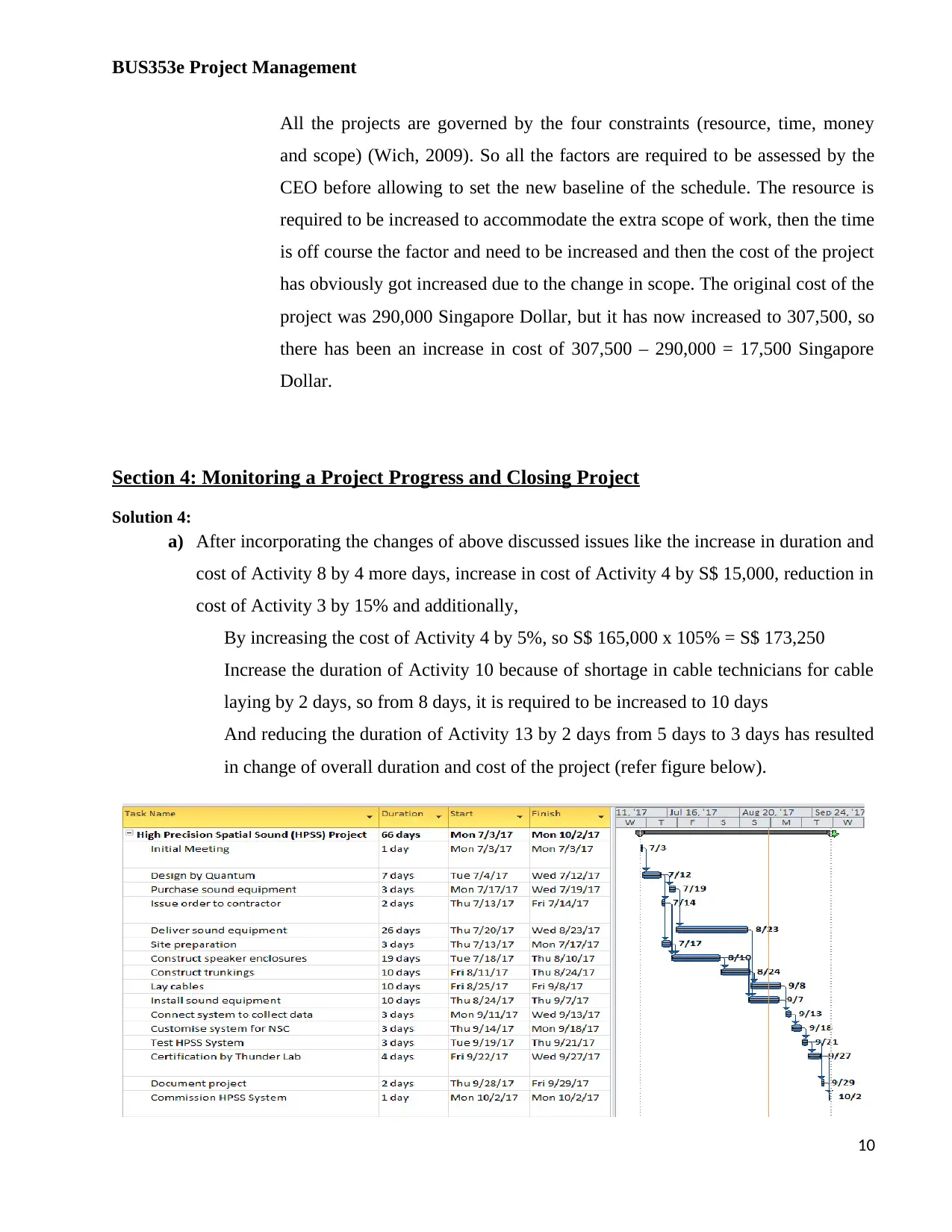
BUS353e Project Management
All the projects are governed by the four constraints (resource, time, money
and scope) (Wich, 2009). So all the factors are required to be assessed by the
CEO before allowing to set the new baseline of the schedule. The resource is
required to be increased to accommodate the extra scope of work, then the time
is off course the factor and need to be increased and then the cost of the project
has obviously got increased due to the change in scope. The original cost of the
project was 290,000 Singapore Dollar, but it has now increased to 307,500, so
there has been an increase in cost of 307,500 – 290,000 = 17,500 Singapore
Dollar.
Section 4: Monitoring a Project Progress and Closing Project
Solution 4:
a) After incorporating the changes of above discussed issues like the increase in duration and
cost of Activity 8 by 4 more days, increase in cost of Activity 4 by S$ 15,000, reduction in
cost of Activity 3 by 15% and additionally,
By increasing the cost of Activity 4 by 5%, so S$ 165,000 x 105% = S$ 173,250
Increase the duration of Activity 10 because of shortage in cable technicians for cable
laying by 2 days, so from 8 days, it is required to be increased to 10 days
And reducing the duration of Activity 13 by 2 days from 5 days to 3 days has resulted
in change of overall duration and cost of the project (refer figure below).
10
All the projects are governed by the four constraints (resource, time, money
and scope) (Wich, 2009). So all the factors are required to be assessed by the
CEO before allowing to set the new baseline of the schedule. The resource is
required to be increased to accommodate the extra scope of work, then the time
is off course the factor and need to be increased and then the cost of the project
has obviously got increased due to the change in scope. The original cost of the
project was 290,000 Singapore Dollar, but it has now increased to 307,500, so
there has been an increase in cost of 307,500 – 290,000 = 17,500 Singapore
Dollar.
Section 4: Monitoring a Project Progress and Closing Project
Solution 4:
a) After incorporating the changes of above discussed issues like the increase in duration and
cost of Activity 8 by 4 more days, increase in cost of Activity 4 by S$ 15,000, reduction in
cost of Activity 3 by 15% and additionally,
By increasing the cost of Activity 4 by 5%, so S$ 165,000 x 105% = S$ 173,250
Increase the duration of Activity 10 because of shortage in cable technicians for cable
laying by 2 days, so from 8 days, it is required to be increased to 10 days
And reducing the duration of Activity 13 by 2 days from 5 days to 3 days has resulted
in change of overall duration and cost of the project (refer figure below).
10
Paraphrase This Document
Need a fresh take? Get an instant paraphrase of this document with our AI Paraphraser
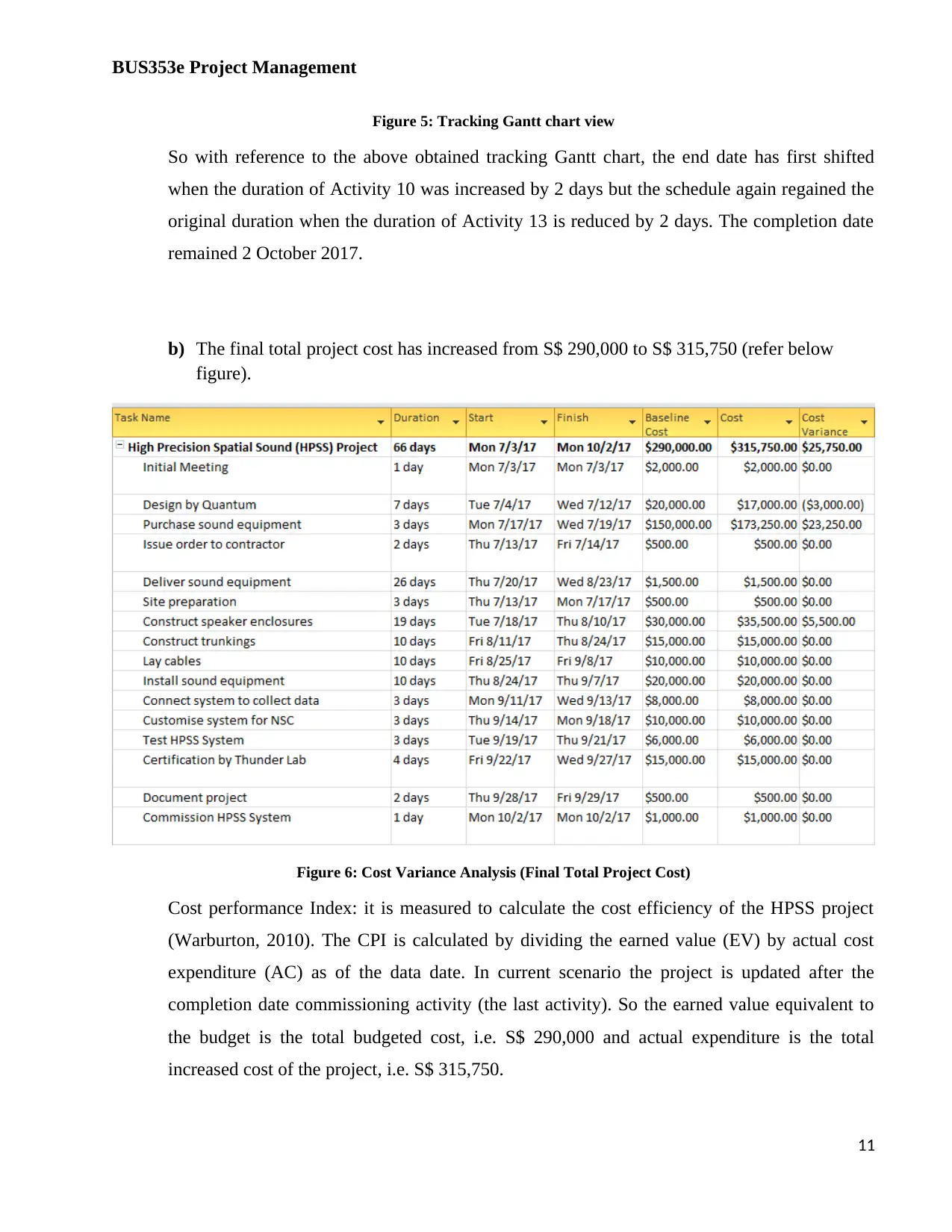
BUS353e Project Management
Figure 5: Tracking Gantt chart view
So with reference to the above obtained tracking Gantt chart, the end date has first shifted
when the duration of Activity 10 was increased by 2 days but the schedule again regained the
original duration when the duration of Activity 13 is reduced by 2 days. The completion date
remained 2 October 2017.
b) The final total project cost has increased from S$ 290,000 to S$ 315,750 (refer below
figure).
Figure 6: Cost Variance Analysis (Final Total Project Cost)
Cost performance Index: it is measured to calculate the cost efficiency of the HPSS project
(Warburton, 2010). The CPI is calculated by dividing the earned value (EV) by actual cost
expenditure (AC) as of the data date. In current scenario the project is updated after the
completion date commissioning activity (the last activity). So the earned value equivalent to
the budget is the total budgeted cost, i.e. S$ 290,000 and actual expenditure is the total
increased cost of the project, i.e. S$ 315,750.
11
Figure 5: Tracking Gantt chart view
So with reference to the above obtained tracking Gantt chart, the end date has first shifted
when the duration of Activity 10 was increased by 2 days but the schedule again regained the
original duration when the duration of Activity 13 is reduced by 2 days. The completion date
remained 2 October 2017.
b) The final total project cost has increased from S$ 290,000 to S$ 315,750 (refer below
figure).
Figure 6: Cost Variance Analysis (Final Total Project Cost)
Cost performance Index: it is measured to calculate the cost efficiency of the HPSS project
(Warburton, 2010). The CPI is calculated by dividing the earned value (EV) by actual cost
expenditure (AC) as of the data date. In current scenario the project is updated after the
completion date commissioning activity (the last activity). So the earned value equivalent to
the budget is the total budgeted cost, i.e. S$ 290,000 and actual expenditure is the total
increased cost of the project, i.e. S$ 315,750.
11
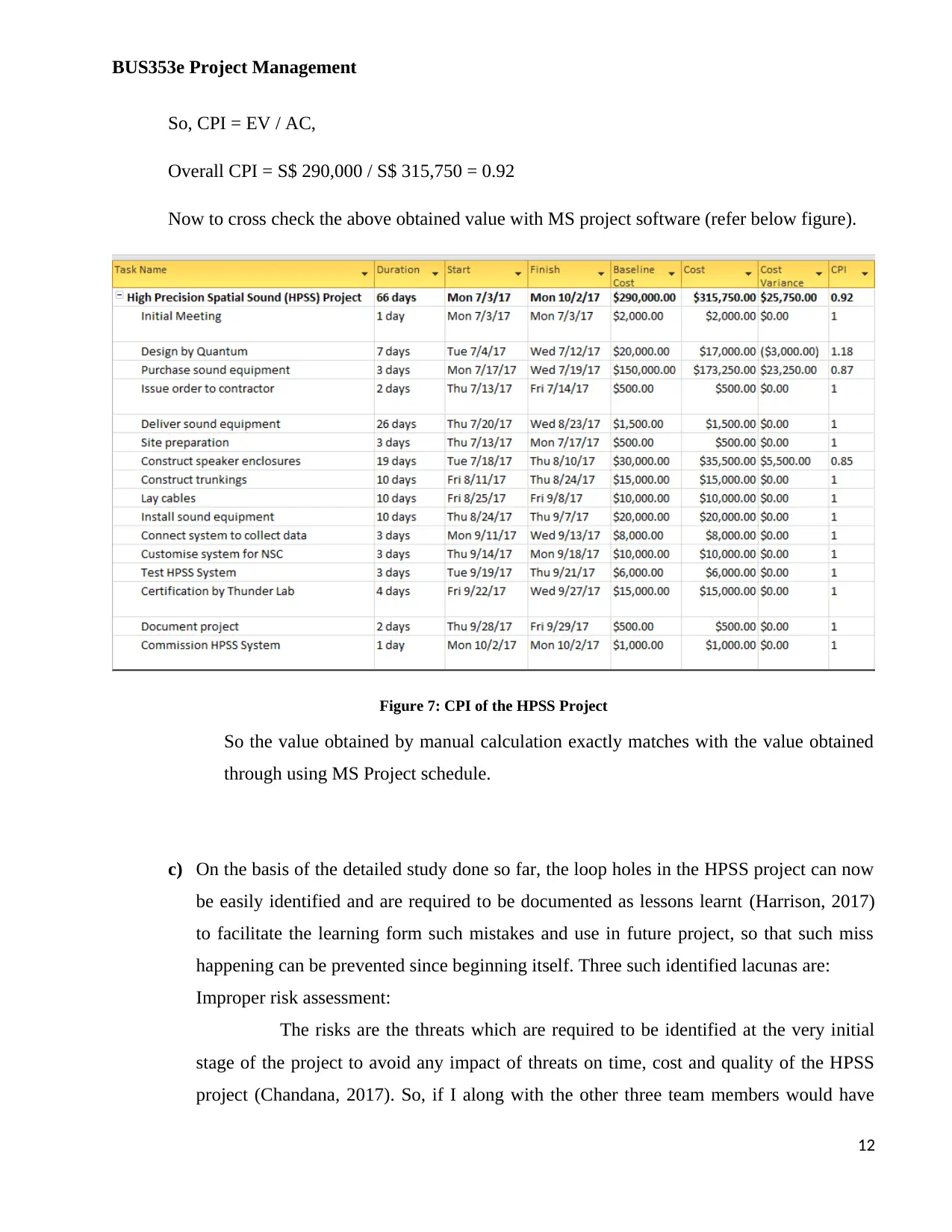
BUS353e Project Management
So, CPI = EV / AC,
Overall CPI = S$ 290,000 / S$ 315,750 = 0.92
Now to cross check the above obtained value with MS project software (refer below figure).
Figure 7: CPI of the HPSS Project
So the value obtained by manual calculation exactly matches with the value obtained
through using MS Project schedule.
c) On the basis of the detailed study done so far, the loop holes in the HPSS project can now
be easily identified and are required to be documented as lessons learnt (Harrison, 2017)
to facilitate the learning form such mistakes and use in future project, so that such miss
happening can be prevented since beginning itself. Three such identified lacunas are:
Improper risk assessment:
The risks are the threats which are required to be identified at the very initial
stage of the project to avoid any impact of threats on time, cost and quality of the HPSS
project (Chandana, 2017). So, if I along with the other three team members would have
12
So, CPI = EV / AC,
Overall CPI = S$ 290,000 / S$ 315,750 = 0.92
Now to cross check the above obtained value with MS project software (refer below figure).
Figure 7: CPI of the HPSS Project
So the value obtained by manual calculation exactly matches with the value obtained
through using MS Project schedule.
c) On the basis of the detailed study done so far, the loop holes in the HPSS project can now
be easily identified and are required to be documented as lessons learnt (Harrison, 2017)
to facilitate the learning form such mistakes and use in future project, so that such miss
happening can be prevented since beginning itself. Three such identified lacunas are:
Improper risk assessment:
The risks are the threats which are required to be identified at the very initial
stage of the project to avoid any impact of threats on time, cost and quality of the HPSS
project (Chandana, 2017). So, if I along with the other three team members would have
12
⊘ This is a preview!⊘
Do you want full access?
Subscribe today to unlock all pages.

Trusted by 1+ million students worldwide
1 out of 14
Your All-in-One AI-Powered Toolkit for Academic Success.
+13062052269
info@desklib.com
Available 24*7 on WhatsApp / Email
![[object Object]](/_next/static/media/star-bottom.7253800d.svg)
Unlock your academic potential
Copyright © 2020–2025 A2Z Services. All Rights Reserved. Developed and managed by ZUCOL.

